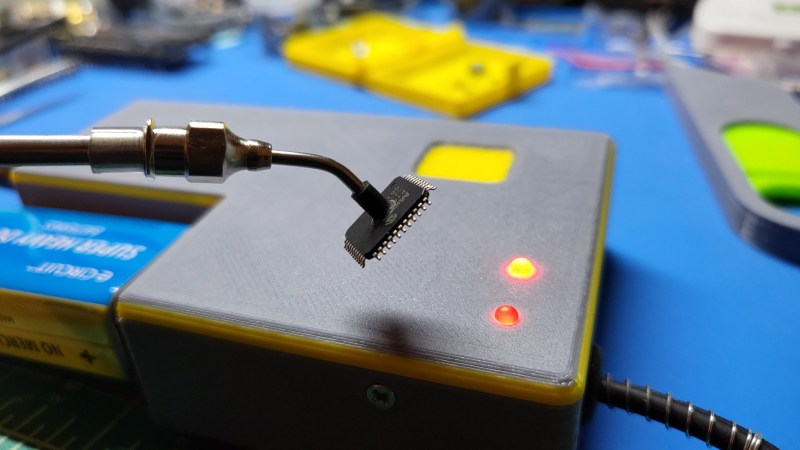Anyone who’s ever assembled a PCB full of tiny SMD parts will have found that tweezers are not always the best tool when it comes to accurate positioning. Thin, flat components like microcontrollers can be awkward to pick up securely, while small resistors and capacitors have a tendency of snapping out of your tweezers’ grip and flying off into the sunset (or your carpet). Vacuum pickup tools can be a great help, but the most convenient models, with an electric air pump and a foot switch, can be a bit expensive. [sjm4306] shows that it doesn’t have to be that way: he built his “VacPen” mostly from reused components.
At the heart of the project is a little vacuum pump with a pen-like device hooked up to it through a flexible hose. The tip of the pen holds a pickup nozzle that came from a cheap manual pick and place tool. Both the pump and pen were salvaged from some gas analysis instrument that [sjm4306] tore apart a long time ago; the pen is especially convenient since it comes with a built-in brush-like filter that can trap any debris or tiny parts that might be accidentally swallowed.
The VacPen controller is housed inside a neat 3D printed enclosure that holds a custom PCB with an ATtiny microcontroller. The pump can be operated either through a foot switch, or by pressing on the touch-sensitive pad on top of the enclosure. [sjm4306] made this by soldering a wire to a copper penny and sticking it on the inside of the lid: simple, effective and cheap.
As you can see in the video embedded below, the VacPen is perfectly capable of picking up any kind of SMD component, and just as importantly, immediately releasing it at the desired moment. If you’re new to SMD technology, we can recommend this tutorial by [Bil Herd] that covers vacuum tweezers as well. If you’re more into automating vacuum pickup tools, this cool robot might be of your interest.


















Your project sucks! … Can I get away with saying that for once :-D
Looks handy, I used to be a whizz with tweezers, but someone seems to have replaced all my tweezers with identical looking component projection launchers, *ping zzzzzip* there goes another one.
In my pre-coffee haze, I initially saw in the headline “Make A Meat Vacuum Pickup Tool”. Sometimes we make our own comedy.
I made one of these a few years ago, when I needed to assemble quite a few prototype boards.
I went the mains powered and a foot switch route, without any microcontrollers or pointless complications.
I also made an XY slider table on which I can rest the palm of my hand and rapidly glide from PCB to component tape or tray. Later I added a microscope camera on the tray to make it even easier to place the smaller components such as 0201 and 0402 passives and the like.
This projects demonstrates once again that touch sensitive buttons are cool, but are not to be used everywhere. The response time of the button in this video is infuriatingly slow, and just takes away the time savings of having a vacuum pen.
Absolutely no reason touch sensing should be noticeably delayed, I just didn’t tune the sensitivity from when I was testing the circuit on breadboard. I can assure you that will be fixed as soon as I get the free time. I do agree though that a footswitch is where it’s at freeing up both hands, luckily I did add a rear jack into my design to allow for input flexibility. I also opted for battery power instead of mains because of my specific use case requirements, but it would be trivial to make an adapter to allow a dc plug to power the whole thing. I just don’t see the point of being tethered to a wall outlet for such a simple device that can just as easily run off of battery.
In my case I don’t see any occasion where I will not have mains power nearby, and have the need to fit parts to a board.
I have just thought of an additional mode you could use when on battery power and placing small components. That is running the pump for a few seconds before stopping it, holding the vacuum until the button is pressed again to actuate the solenoid. For small components the negative pressure in the hose/pen will be sufficient to hold an 0402 component for about a minute, save some battery and reduce the noise.
That’s an interesting idea, I’ll have to experiment with timing to see if it’d be useful for prolonging battery life and reducing noise during use.